
Optimizing the Power of Platforms:
Creating a Platform App Factory
Full Digital Transformation In A Flexible Model
Platform Application Factory
Extracting greater Value from your Platform Investment

Why a Platform
Application Factory
The value proposition for low-code application platforms is simple: speed. Time to deliver, iterate, enhance, and transform. As your organization matures its use of these platforms, your industry partners have a responsibility to bring innovative tools, practices, and ideas to optimize your investments at speed.
To support this, the Deloitte team has developed an approach — the Platform Application Factory – to maximize the value of your ServiceNow platform investments now and into the future. This approach delivers platform applications via multi-disciplinary teams that can accelerate quality digital transformation at scale.
Deloitte has guided leading companies on similar platform-based journeys to accelerate digital transformation at scale. By creating a centralized ServiceNow platform development hub, these organizations maximized delivery speed in multi-platform environments.

Platform Application Factories that leverage ServiceNow are of greatest value to product line owners and stakeholders when these teams’ different platform skills are paired with a scalable and flexible procurement vehicle. And since different application use cases require a different mix of skillsets, we believe organizations benefit from access to a vehicle housing a broad spectrum of ServiceNow platform-based expertise – like consulting, digital design, development and change management – that can combine services as your mission demands. Dynamic vehicles like these could create value and efficiency by decreasing overhead, accelerating delivery, and providing traceability and financial transparency to product owners.
Note that while we believe that Platform Application Factory teams should provide insight and implementation experience as they relate to platform capabilities, the selection of the particular technology remains the responsibility of our government partners. Our hope is that this document sparks ideas, conversations, and innovation – a process in which Deloitte would be both excited and honored to participate.

In a world radically transformed by COVID-19, where change is increasingly the only constant, government organizations will need to become far more agile and adaptive to serve citizens effectively and deliver on their missions. How can they get there in this new operating environment?
Low-Code Application Platforms: definition and outlook
Gartner defines a low-code application platform (LCAP) as
an application platform that supports rapid application development, one-step deployment, execution and management using declarative, high-level programming abstractions, such as model-driven and metadata-based programming languages. They support the development of user interfaces, business logic and data services, and improve productivity at the expense of portability across vendors, as compared with conventional application platforms."
This definition encompasses the ecosystems on which the Platform Application Factory produces products.
Low-Code Application Platforms:
Platform App Factory solution overview
Deloitte’s Platform Application Factory framework provides a single approach to application delivery: an efficient, effective, and repeatable process that simplifies and accelerates platform development across complex environments. The framework models the best practices of a modern factory, with components developed in specific sections of the factory floor and making their way down the production line to the customer:
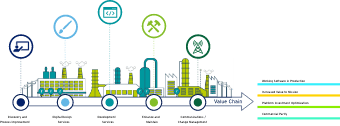
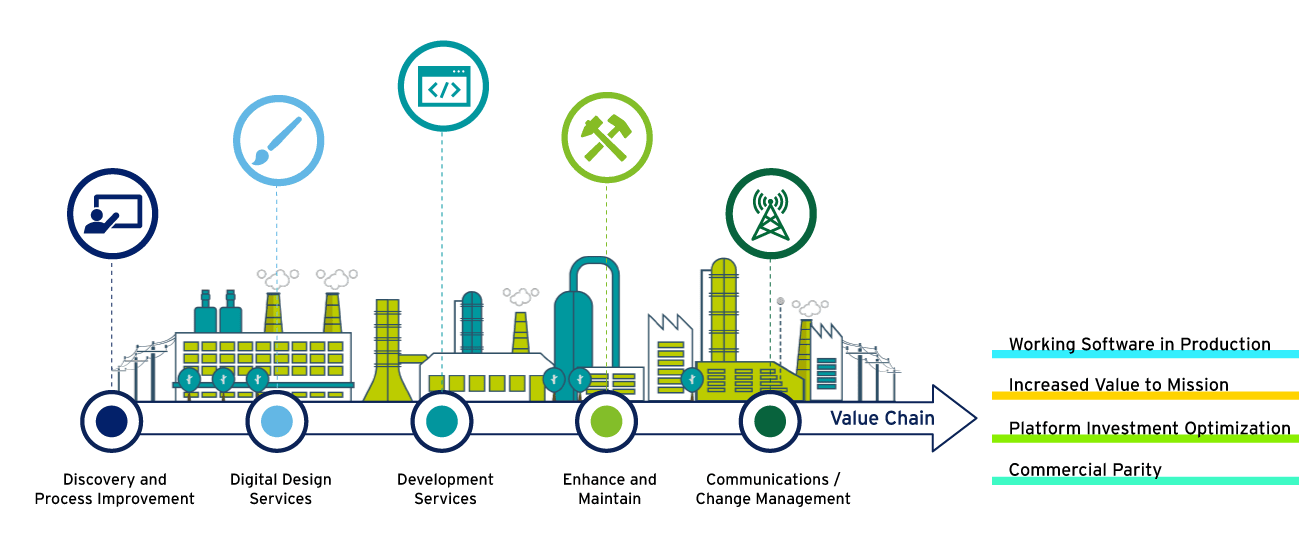
The Platform Application Factory model aggregates services such that strategic expertise, agile delivery methods, and innovative thinking inform the very platforms that enable them. An organization that employs this model is thus able to deliver the services of a true, integrated creative digital consultancy, quickly transforming its customers’ digital journeys in ways traditional delivery models cannot.

This tailored methodology is the result of Deloitte’s on-the-ground experience with a broad array of engagements across government organizations, coupled with our ServiceNow expertise and a well-established Factory Operations Center.
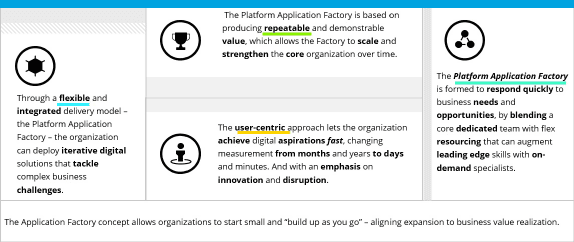
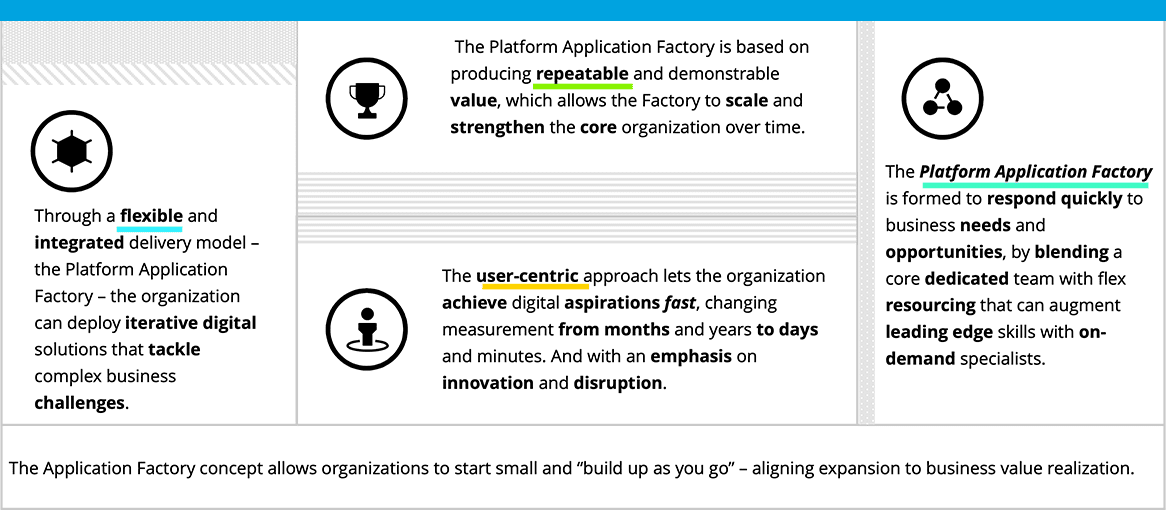

The Application Factory Framework. Deloitte can incrementally deliver ServiceNow value in each section of the Application Factory by applying our Agile approach, human centric/design thinking practices, and leading software development capabilities – a framework that allows for full service end-to-end delivery as well as a flexible à la carte model.
Factory Operations Center. An efficient, cost effective, and self-sustaining capability like an App Factory needs governance and business models from the start. To support this, we recommend establishing a Factory Operations Center that includes elements like these:
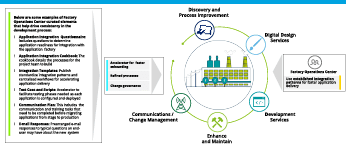
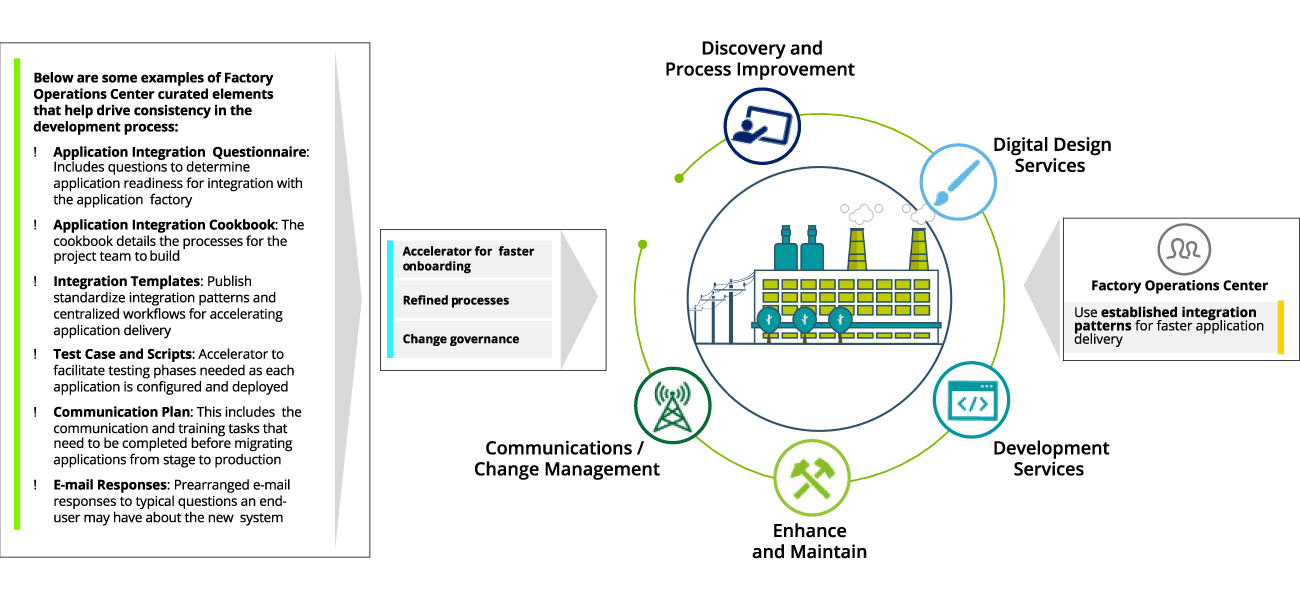
A key purpose of a Factory Operations Center standup is to create and sustain a scalable offering while supporting multiple solutions. Deloitte will partner with clients to advise and establish a Factory Operations Center that will manage process, policy, and strategy.
An efficient factory has forepersons that ensure the proper resources have been deployed, coordinated, and managed in such a way that they strengthen the institution’s purpose.
The forepersons in the Factory Operations Center create and drive critical components that streamline delivery at each section of the Application Factory. Ultimately, the Factory Operations Center and its forepersons are responsible for making sure that the right resources are readily available at the right section of the factory floor.

Your customers are looking for teams to help them achieve digital transformation through platforms. Such transformations aren’t accomplished by simply handing requirements for tech solutions to monolithic teams; they’re accomplished by partnering with integrated, cross-functional teams to explore how the power of ServiceNow platforms can be used to reimagine the way you work. Teams that represent the full spectrum of digital transformation services – from engineers, to designers, to analysts and business experts.
The vehicle allows for offsite ServiceNow development, which expands the potential talent pool, increases available technology capabilities, and can decrease development costs.
As your organization is constantly bringing in new platforms, it needs a vehicle with access to subject matter experts with experience setting up these platforms (along with governance processes, so you can get the most out of your investments).
Your organization is transitioning from waterfall to agile development, a transformation that can be accelerated by adopting a new, streamlined contract vehicle that enhances agile development by ensuring that cost controls, best practices, constant process improvement, and human centered design elements are consistently applied across the software development lifecycle.

Platform App
Factory Contract
The establishment of a Factory Operations Center delivers on an organization’s digital transformation journey by establishing a centralized unit of dedicated people with a mission to streamline access to high-demand capabilities for rapid execution across the business. The Factory Operations Center’s goals include, but are not limited to, standardization enforcement, standardized intake processes for requirements gathering and providing Rough Orders of Magnitude (ROMs), asset library, development best practices, strategic partnership support across the organization, and an outcome-based governance capability allowing for continuous transformation of the Enterprise. As the Center matures, it becomes a self-directing entity responsible for supporting business users and shepherding complex projects to successful completion resulting in the realization of the organization’s goal of digital transformation.
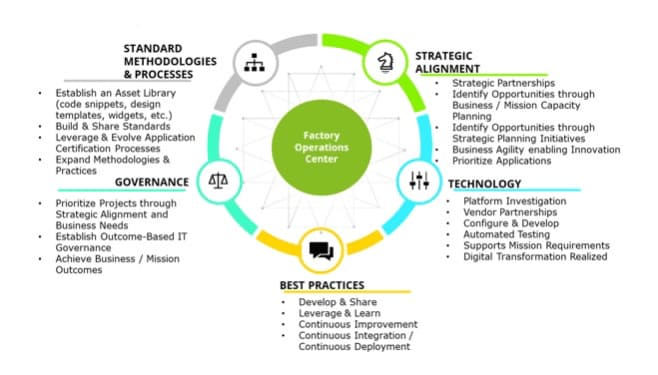
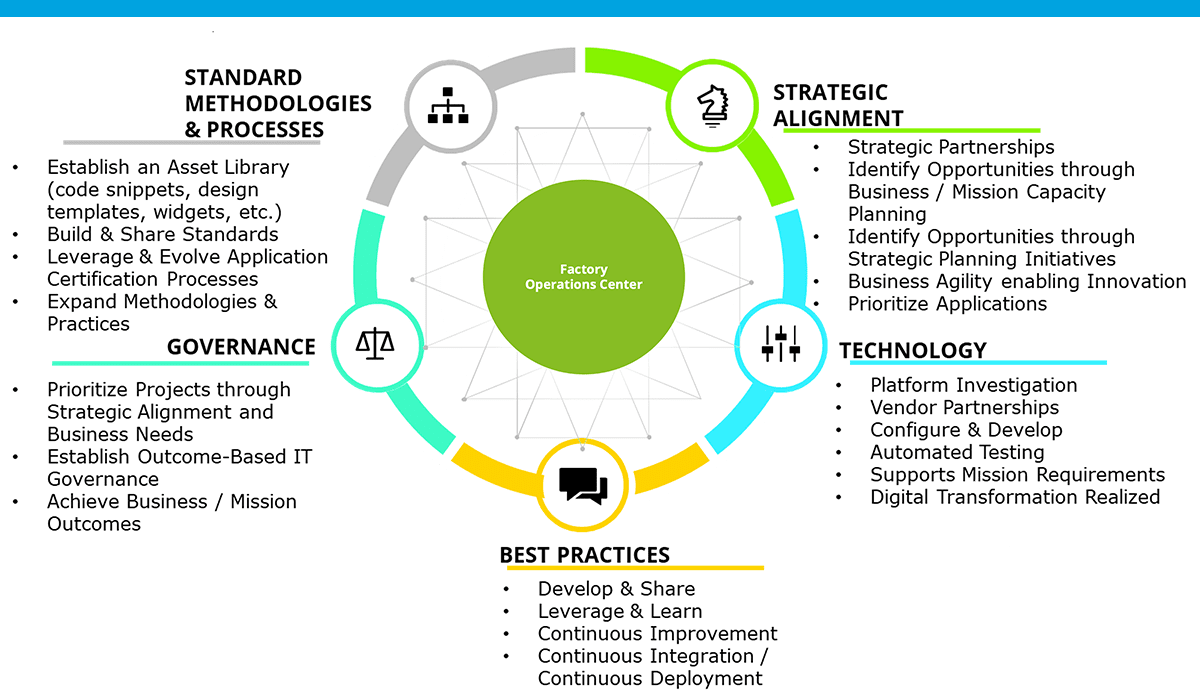

The Factory Operations Center, as depicted in Figure 2.1-1, outlines the features and benefits that transform the business or mission areas by looking at enterprise transformation through strategic contribution and alignment. It drives innovation across the enterprise as well as uncover new strategic capabilities, products, and/or business models along the way. The Center model fosters collaboration between IT and the business leading to a more modern IT Enterprise with the ability to adapt and change rapidly when requirements dictate.
The Factory Operations Center business value is quantified through several Key Performance Indicators (KPIs). Consistent KPIs that communicate progress toward the organization’s larger goals include: Number of Projects / Releases Deployed, Development Costs per Process Set, Bug / Defect Rate, ServiceNow Opportunities in the Pipeline, and Solution Responsiveness to name a few.
Discovery informs early decisions that set the product on the right path through the app
factory
Discovery is part of what separates human-centered, digital transformation and product
development enabled by platforms the from technology-centered, traditional systems development
built on custom code and ERPs. Whereas
traditional systems development focuses on the technologies and integrations (the how) to
achieve requirements (the what), discovery refocuses on defining the whole problem in terms of
the full set of questions important
to the business and the people involved in it and affected by it. Discovery adds who the product
is for and what they need in the context of when they need it and why. Discovery expands the
possible outcomes from a best
case of meeting a requirement to changing user behavior to improve business outcomes in
measurable ways driven by strategy.

Discovery deliverables include:
To understand and build an application for end users, we create visual representations of them, including their goals, pain points, needs, and wants.
(Figure 2.2-1)
Once we’ve mapped out the personas for a product, we create Journey maps to represent their path through the process/application. This can include their pain points in different process steps.
That set the product roadmap and promotes a shared understanding of the context for each ServiceNow product. It considers the current state, what has been tried, pain points, and gaps(that may lead to risks).
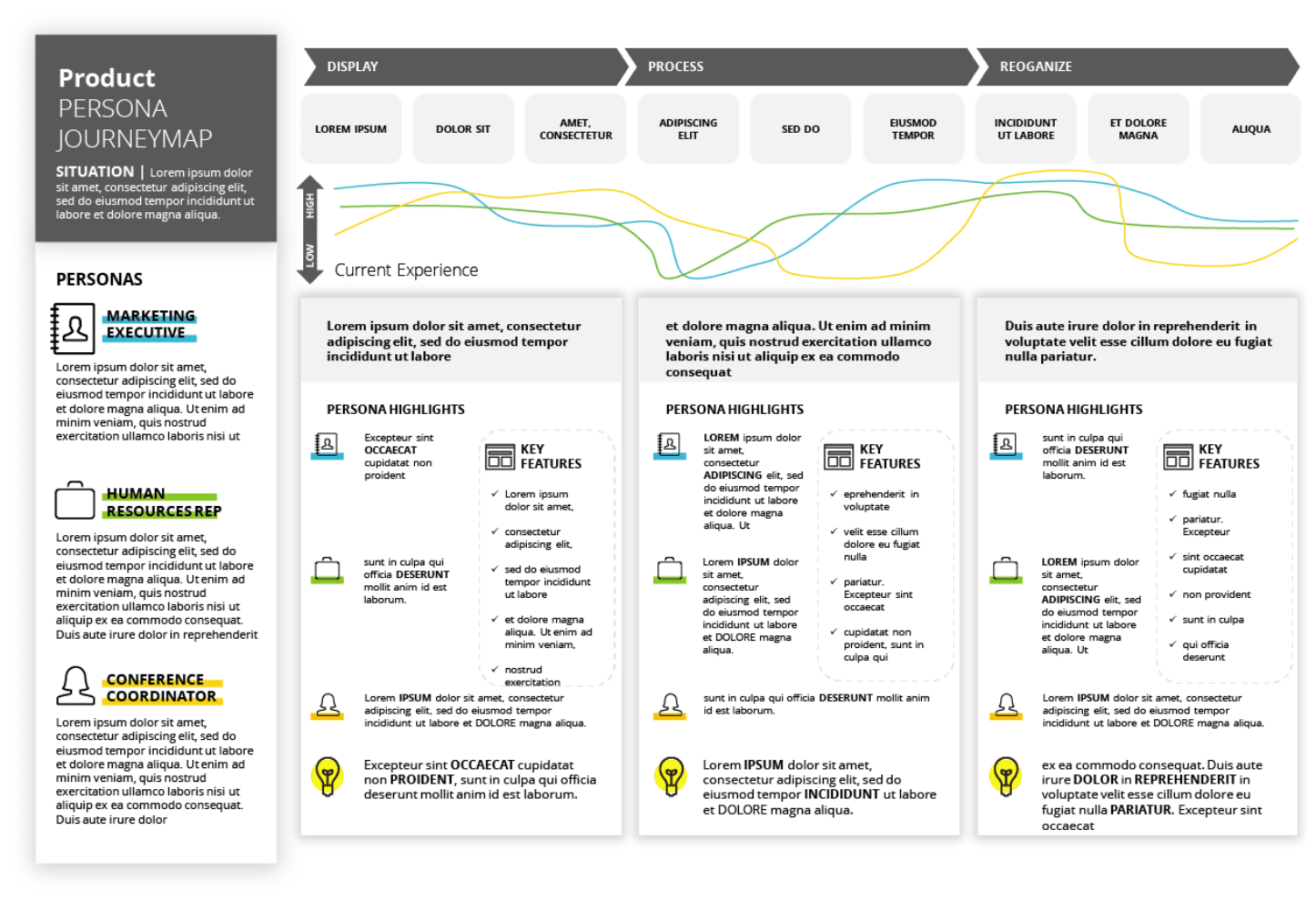

These deliverables set a solid foundation for the product, informing the strategy and governance updates that occur throughout the product lifecycle, visualizing the product development to give stakeholders a sense of ownership, and incorporating input from both technical and non-technical staff at all ranks in the organization. A product enabled by discovery is desirable (meeting customer needs), feasible (meeting technical needs), and viable (meeting business needs).
Discovery continues through development to guide the product to success and sustained
value
Discovery continues throughout design and development to progressively elaborate business needs
into design and development-ready tasks and user stories. As we progress though discovery, it
feeds back to strategy and
governance by identifying business cases that may be better suited for different platforms and
development locations.
Effective discovery identifies the appropriate ServiceNow reusable assets, modules within a platform, or discrete products to meet the business need. It adapts to and drives service strategy changes from the product level. Discovery identifies discrete products that align with the service strategy and identifies opportunities to integrate or merge products where there is business value to do so. Finally, discovery informs these decisions by reframing the challenge in terms of the five W’s over how.
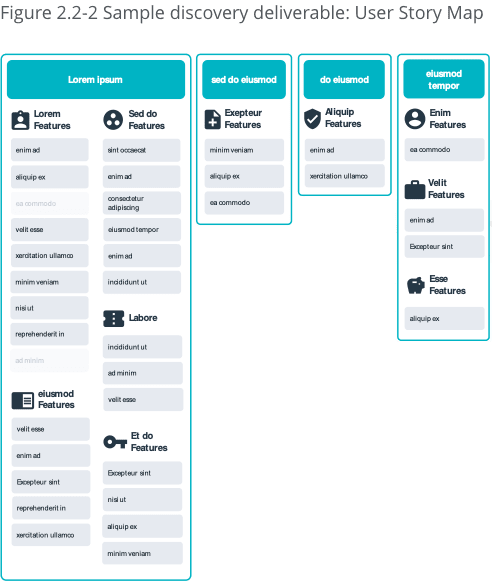

The user experience of an application effectively represents a personification of the system and is the first impression a customer has of an organization. It encompasses everything including the interface that users interact with, the tone that text conveys (i.e. is it profession and all business or lighter and more friendly?), the clarity of instructions, and helpfulness of any error states. Everything from colors to fonts to icons can subconsciously impact a user’s reaction to an application. A sloppy and confusing user experience makes even the most complex and fully functional systems feel extremely frustrating. More frustration means more resources dedicated to customer support and more energy to win back a user’s trust. In a sense, bad design is bad for business.
Applications that view design as an afterthought and overlook user experience are either replaced quickly or require significant rework to fix usability. This poses a serious project risk, poor return on investment for customers, and wastes resources that could have been used for future improvements. The solution to this simple problem is a strong emphasis on human centered design and user experience from the onset of the project all the way through to launch. The Platform Application Factory can provide dedicated UI/UX teams that are deployed to customers to help them shape the look and feel of their systems.

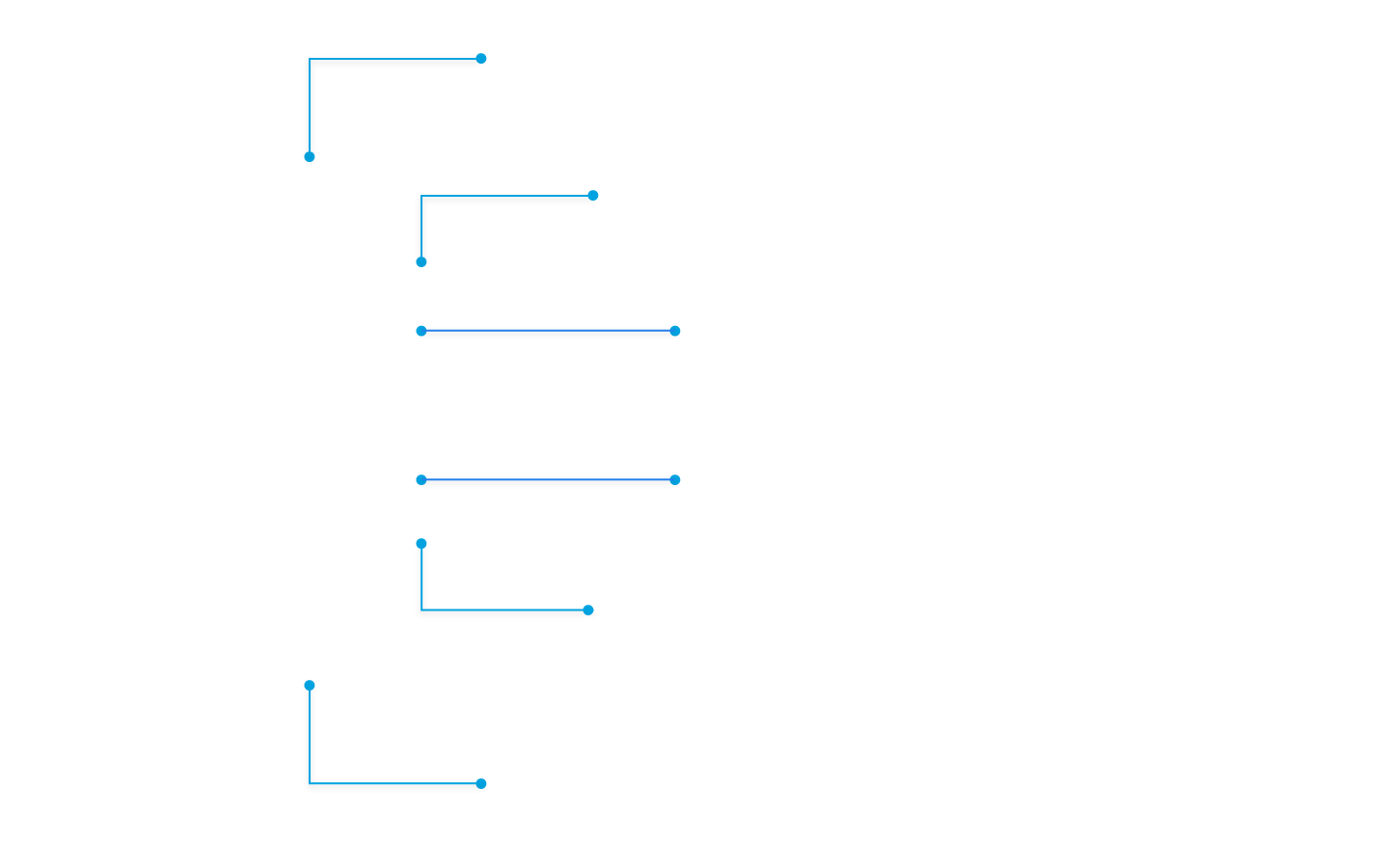
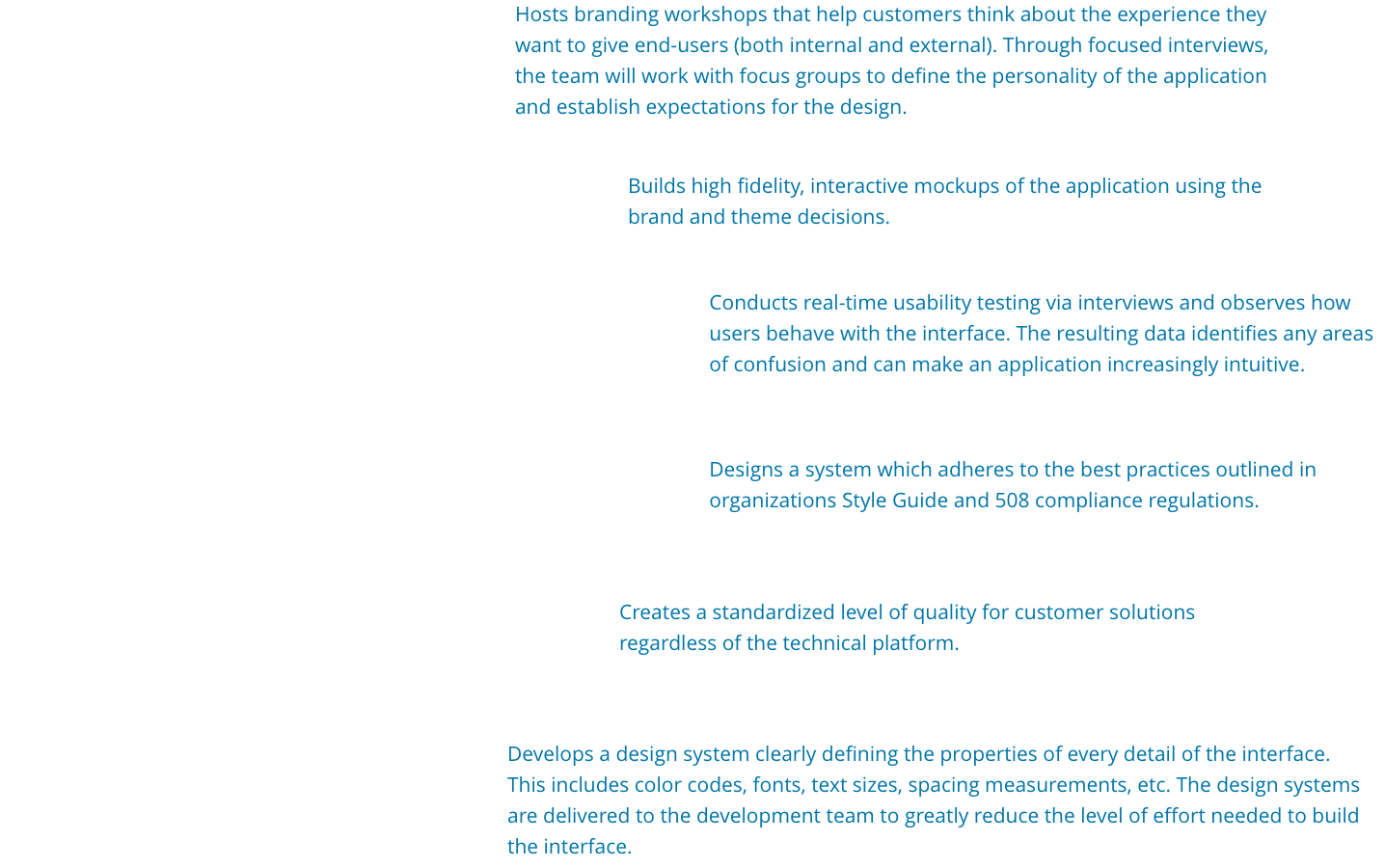
- Hosts branding workshops that help customers think about the experience they want to give end-users (both internal and external). Through focused interviews, the team will work with focus groups to define the personality of the application and establish expectations for the design.
- Builds high fidelity, interactive mockups of the application using the brand and theme decisions.
- Conducts real-time usability testing via interviews and observes how users behave with the interface. The resulting data identifies any areas of confusion and can make an application increasingly intuitive.
- Designs a system which adheres to the best practices outlined in organizations Style Guide and 508 compliance regulations.
- Creates a standardized level of quality for customer solutions regardless of the technical platform. Develops a design system clearly defining the properties of every detail of the interface. This includes color codes, fonts, text sizes, spacing measurements, etc. The design systems are delivered to the development team to greatly reduce the level of effort needed to build the interface.
Deloitte AccelerationDeloitte comes equipped with technology like our Rapidfire solution. A framework that can generate production ready applications in hours with built in UI/UX and module specific data model generation.
By offering a Platform App Factory, organizations can continuously develop and improve solutions for customers. The Platform Application Factory follows the Agile Methodology. Each sprint has planning meetings with product owners and reviews to demonstrate the progress made the cycle.
This level of engagement allows customers to provide feedback throughout the entire process and see tangible progress to confirm the application is meeting their needs before it’s too late. The development team also conducts internal code reviews to ensure that all deliverables are well-documented and follow best practices

Flexibility of anything from no-code out of the box configurations to more complex business rules with a polished user interface. ServiceNow application development should not be “one size fits all” and the Platform Application Factory must have the resources to cover this entire spectrum.

Access to diverse pipelines and infrastructures to handle both sensitive development as well as offsite development. Thanks to platform capabilities, we can package ServiceNow scoped applications from offsite and deploy them on-prem with incredible ease. This flexibility is just another factor that can greatly reduce both the cost and time to market.

Use of three environments: development, test, and production. When development is completed, the team conducts both integration testing with external systems and user acceptance testing (UAT) with customers prior to any deployments. These activities also include automated testing where applicable, comprehensive test scripts, and regression testing. Once the customer signs off, the development team oversees the deployment of the system and provide “hypercare” for the brief time following release to troubleshoot and correct any issues during the rollout.
Even after production deployments, the Platform App Factory model keeps continuous ServiceNow development and continuous deployment in mind. This approach allows ServiceNow applications to be built and released in phases instead of waiting for everything to be completed. Organizations can deliver key functionality to customers sooner while remaining flexible for future enhancements.
Enhance & Maintain
Once a platform app achieves milestones. such as a Minimum Viable Product (MVP), Authority to Operate (ATO), deployment into production, roll-out to real world users, or Full Operational Capability (FOC), the focus of its development eventually changes. Unlike traditional systems, which often switch into a “keep the lights on” maintenance mode that enables the system to continue working regardless of whether its value degrades, ServiceNow abstracts away most of the traditional maintenance activities and enable flexible app enhancement while running. This is where platform owners gain significant value because platforms drive down the cost of ownership. Platform apps can be modified quickly to respond to user feedback, to fix issues that become evident in the data they gather and visualize about user behavior or respond to changing business needs. They simplify integration with Continuous Integration/Continuous Delivery (CI/CD) pipelines and have automated test frameworks as built-in features that automatically run regression tests, stop deployments on test failure, and assure quality before each change. This continual enhancement and maintenance keeps the app alive and relevant, continuing to deliver value by enabling progressively better process, keeping up with the enterprise, and preventing it from becoming a “legacy system.”

ServiceNow App enhancement and maintenance activities require smaller-scale development and contracting methodology than the full-time team executing multiple sprints needed when building operating capability. Platform apps simplify the process of implementing changes over custom apps or ERP-based changes enabling some valuable enhancements to be implemented with far less effort than would warrant a development sprint. Adding a step to a business process, reconfiguring validation rules, updating language embedded in the app, minor rebranding or look-and-feel changes, and setup activities at business cycle boundaries (e.g. fiscal years) need to divert a dev team or require system administrators to be standing by, awaiting a new maintenance task. These sustaining changes are often urgent enough that waiting for enough of them to accumulate to warrant development sprints is not desirable, feasible, or viable. These enhancements and maintenance activities that must occur throughout the life of the product to maintain its value can be delivered in smaller increments where levels of effort are estimated in hours or days rather than weeks or months. To simplify and speed acquisition and reduce risk to the government, these increments can be packaged using a t-shirt sizing model with firm, fixed prices per estimated size.

To maintain product supportability, these enhancements and maintenance activities must incorporate the same standards established by the platform app factory at a smaller scale. Cross-functional support personnel with a background in the full end-to-end change process are necessary including the understanding of the human-centered approach established in discovery and design, the platform app implementation and automatic testing capability delivered during development, and the business savvy developed by continual improvement of the enhancement and maintenance process. This skillset is more collaborative, business-oriented, and human-centered and less technically based and process-oriented than is common among the system administrators, database administrators, and IT operations managers who operate and maintain traditional systems.

Technology without Strategic Communications, such as Change Management, fail to reach users. Employees resist change for the sake of change but the right messaging from the right people, results in technology adoption and business value. Tech organizations are not equipped to drive employee engagement or adoption, this must come from the business organization making the change to their offerings.
To manage change effectively, an organization must:
1) plan and communicate change
2) establish and train owners of change
3) measure performance to demonstrate change
Make people understand the need and value of change.
Recognize the effort and resources necessary to make the change.
Be explicit, and clearly communicate the business outcome of the change.
Analyze the people management challenges and how best to address them.
Success in developing and rolling out any new technology requires input and coordination across numerous roles, many of which do not traditionally report to the technology organization.
Executive sponsorship is required to legitimize the project.
The change management leader has day-to-day responsibility for the initiative.
Change agents are workers in the line of business (LOB).
Collaboration analysts drive business value.
Marketing liaisons create a bridge to the end-users.
Establish a baseline of performance.
Track and measure all program activities.
Use adoption success stories to breed more adoption as an indicator of change.
Measure business results.
Strive for continuous improvement.
While the task of driving adoption of new tools / technologies seems daunting, many examples of success exist. Best practices always focus on establishing recognized business value, including broad user input in shaping the initiative, and addressing training with a broad and varied approach. This is no different. Strategic Communications early and often from both Leadership and Users along with hands-on exposure to the technology to provide input, makes adoption much easier resulting in a win both from the business and IT.
Deloitte suggests a flexible vehicle such as an IDIQ contract structure to support the establishment of an enterprise managed service capability. The Task Order (TO) structure in Table 2.7-1 is designed to promote ServiceNow platform application development control and transparency for the development organization and its business customers.
| Task Orders | Description | Unit Duration | Units |
|---|---|---|---|
| TO1 | PM Services - Factory Operations Center | Base + Option Years | LOE |
| TO2 | Project/Client #1 | 12 Months | See CLINs |
| TO2 | Project/Client #2 | 12 Months | See CLINs |
| TO3 | Project/Client #3 | 12 Months | See CLINs |
| 0001 | Discovery & Process Improvement | 2x2 Weeks Sprints | FFP |
| 0002 | Digital Design Services | 2 Weeks Sprint | FFP |
| 0003 | Platform Application Development Services | 2 Weeks Sprint | FFP |
| 0004 | Platform Application Enhance & Maintain – (T-Shirt Sized) | T-Shirt Sizes | FFP |
| 0005 | Strategic Communications / Change Management | 1 FTE | LOE |
Serving as the foundation for the IDIQ structure, TO1 establishes Platform Application Factory Operations Center to deliver each customer’s journey through the Factory. The Factory Operations Center engages with customers directly to establish the project that is right for their requirements. Additionally, the Factory Operations Center provides answers to programmatic and technical challenges as customers work through the platform governance process (see section 2.1).
Subsequent TOs can be created for every project, allowing customers to leverage the underlying CLIN structure so they can purchase the elements of development (see sections 2.2-2.7) they require. This tailoring allows customers to “bring their own…” for activities like design, enhancements, and strategic communications. Figure 2.7-1 provides three sample task orders in which clients leverage the different CLINs for their projects.
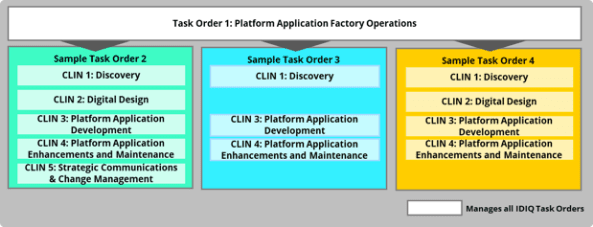
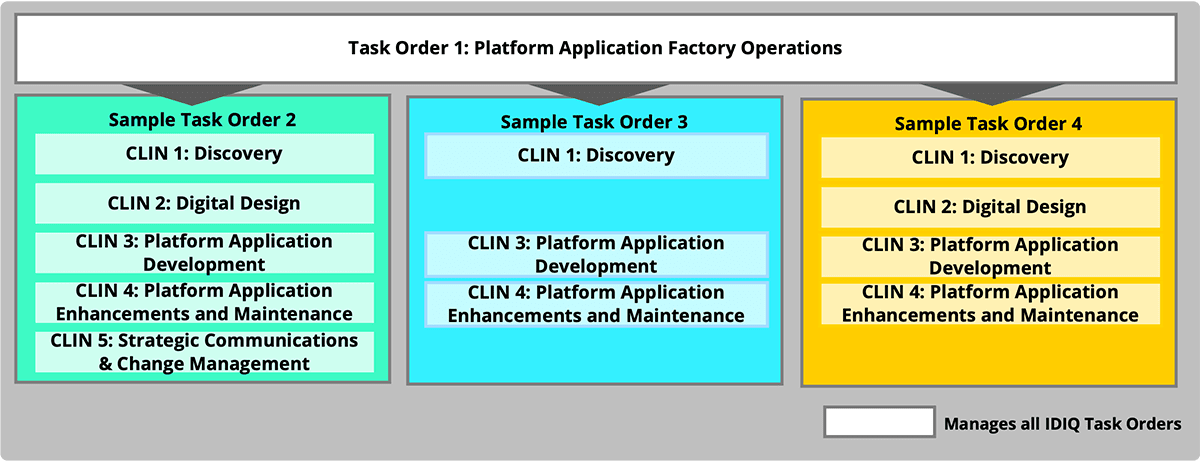
In the example of Sample Task Order (STO) 2, the customer requires all of the services provided by the IDIQ. This is in contrast with the needs of the customer for STO 3 requires flexibility as they are bringing their own design and communications and therefore don’t need that from the factory. By making these decisions up front, the expectations for platform delivery shop and their customers are clear on a contractual level.


Conclusion
Deloitte believes by leveraging a platform application factory delivery model, organizations will be able to provide an end-to-end process to customers that enhances the agile delivery of current and future approved technologies. This new model is made for a new age: the digital creative consultancy, it transforms the customer experience by giving leaders across the organization one place to come to have their digital ambitions brought to life.
Deloitte has the proven experience in deploying ServiceNow platform-based solutions to help the Government agencies deliver the promised value of these technologies further enabling its mission. Evolving usage of ServiceNow platforms, innovative technologies, and DevOps methods require an evolutionary delivery approach where many skills can be accessed quickly. By investing in the Platform Application Factory, organizations will have the ability to deliver faster, more cost efficient, truly digital transformation capabilities. The contract structure outlined in this whitepaper provides organizations with a framework to not only address transformation goals but also provide a capability that can be leveraged across the entire organization.

